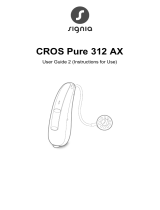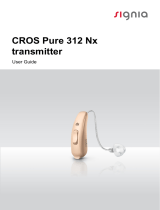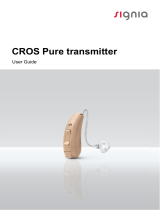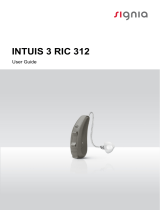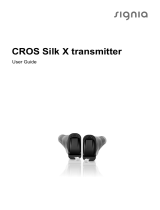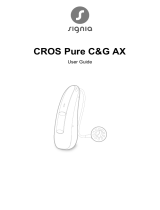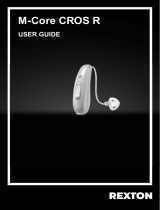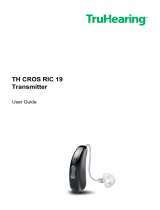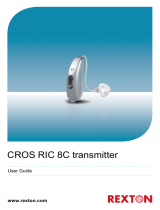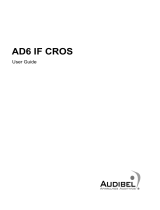Page is loading ...

CROS Pure 312 X
Transmitter
User Guide 2 (Instructions for Use)


CAUTIONCAUTION
It is important to read this user guide and
the user guide 1 (safety manual) thoroughly
and completely. Follow the safety
information to avoid damage or injury.

2 3
Content
Welcome 4
Your CROS transmitter 5
Components and names 7
Controls 9
Hearing programs 10
Signal tones 10
Batteries 11
Battery size and handling tips 11
Replacing batteries 12
Daily use 13
Turning on and o 13
Switching to andby mode 14
Inserting and removing the transmitter 15
Changing the hearing program 19
Bluetooth 19
Maintenance and care 20
Transmitter 20
Ear pieces 21
Professional maintenance 23
Further information 24
Safety information 24
Accessories 24
Explanation of symbols 24
Troubleshooting 26
Conformance information 27
Country-specic information 29
Important safety information 30
Personal safety 30
Product safety 33
Service and warranty 35

4 5
Welcome
Thank you for choosing one of our hearing inrument
accessories.
This guide, along with support from your Hearing Care
Professional, will help you underand the advantages
and greater quality of life this accessory oers.
CAUTION
It is important to read this user guide thoroughly
and completely. Follow the safety information to
avoid damage or injury.
Your CROS transmitter
CROS solutions are designed for people with profound
hearing loss in one ear which can not be aided with a
hearing inrument. A CROS transmitter worn on this
ear captures sound from this side and transmits it to
the hearing inrument on the other ear. This allows the
wearer of the hearing inrument to hear sounds from
both sides.
CROS transmitter hearing inrument

6 7
Two solutions are available:
●CROS solution:
For people with normal hearing in one ear and
profound hearing loss in the other. Sounds from the
side with hearing loss are captured and transmitted
wirelessly to the good‑hearing side.
●BiCROS solution:
For people with profound hearing loss in one ear
and less severe hearing loss in the other. Sounds
from the more severe hearing loss side are captured
and transmitted wirelessly to the better‑hearing side.
The hearing inrument processes and amplies the
sounds from both sides.
The CROS transmitter works with our specic wireless
hearing inruments. Your Hearing Care Professional will
advise you on the compatible models.
NOTICE
This user guide only applies to the CROS
transmitter. Your hearing inrument has a separate
user guide.
Components and names
➐
➏
➊➋
➍
➎
➌
➊Ear piece
➋Receiver
➌Receiver cable
➍Microphone
openings
➎Rocker switch (control, on/o
switch)
➏Battery compartment
➐Side indicator (red = right ear,
blue = left ear) and receiver
connection
Ear piece, retention receiver and receiver cable are only
used to hold the device on the ear. No sound is played.

89
You can use the following andard ear pieces:
Standard ear pieces Size
Click Sleeve (vented or
closed)
Click Dome™ single
(open or closed)
Click Dome semi‑open
Click Dome double
You can easily exchange the andard ear pieces. Read
more in section "Maintenance and care".
Cuom-made ear pieces
Cuom shell
Click Mold™
Controls
With the rocker switch you can, for example, switch
hearing programs. The Hearing Care Professional has
programmed your desired functions to the rocker switch.
Rocker switch function L R
Press briey:
Program up/down
Press for about 2 seconds:
Program up/down
Press for more than 3 seconds:
Turn on/o
L = Left, R = Right
You can also use a remote control to change
hearing programs and adju the volume of your
hearing inruments. With our smartphone app you
have even more control options.

10 11
Hearing programs
1
2
3
4
5
6
Read more in section "Changing the hearing program".
Signal tones
Signal tones of the CROS transmitter ‑ like a low battery
beep - are sent to the hearing inrument.
Ask your Hearing Care Professional to congure the
signal tones.
Batteries
When the battery is low the sound becomes weaker
or you will hear an alert signal. The battery type will
determine how long you have to replace the battery.
Battery size and handling tips
Ask your Hearing Care Professional for recommended
batteries.
Battery size: 312
●Always use the correct battery size for your device.
●Remove the batteries if you intend not to use the
device for several days.
●Always carry spare batteries.
●Remove empty batteries immediately and follow your
local recycling rules for battery disposal.

12 13
Replacing batteries
Removing the battery:
XOpen the battery compartment.
XUse the magnet ick to pull out the
battery. The magnet ick is available
as an accessory.
Inserting the battery:
XIf the battery has a protective lm, remove it
only when you are ready to use the battery.
XInsert the battery with the "+" symbol
facing up (refer to the picture).
XCarefully close the battery compartment. If you feel
resiance, the battery is not inserted correctly.
Do not attempt to close the battery compartment by
force. It can be damaged.
Daily use
Turning on and o
You have the following options to turn your device on or
o.
Via battery compartment:
XTurning on: Close the battery compartment.
The default volume and hearing program are set.
XTurning o: Open the battery compartment to the r
catch.
Via rocker switch:
XTurning on: Press and hold the lower
part of the rocker switch until the
artup melody arts to play. Release
the rocker switch while the melody is
playing.
The default volume and hearing
program are set.
XTurning o: Press and hold upper
or lower part of the rocker switch
for several seconds. A power down
melody is played.

14 15
Switching to andby mode
Via remote control or smartphone app, you can switch
your device to andby mode. This mutes the device.
When you leave andby mode, the previously used
volume and hearing program are set.
Note:
● In andby mode, the device is not turned o
completely. It draws some power.
Therefore we recommend to use andby mode only
for a short period of time.
● If you want to leave andby mode, but the remote
control or app is not at hand: Turn your device o and
on again (via rocker switch or by opening and closing
the battery compartment). In this case, the default
volume and hearing program are set.
Inserting and removing the transmitter
Colored markers indicate the side:
● red marker = right ear
● blue marker = left ear
Inserting:
XFor Click Sleeves, take care that the
bend of the Click Sleeve is in line with
the bend of the receiver cable.
Correct:
Incorrect:

16 17
XHold the receiver cable at the bend closer to the
ear piece.
XCarefully push the ear piece in
the ear canal ➊.
XTwi it slightly until it sits well.
Open and close your mouth to
avoid accumulation of air in the
ear canal.
XLift the device and slide it over
the top of your ear ➋.
CAUTION
Risk of injury!
XInsert the ear piece carefully and not too deeply
into the ear.
●It may be helpful to insert the right device with
the right hand and the left device with the left
hand.
●If you have problems inserting the ear piece,
use the other hand to gently pull your earlobe
downwards. This opens the ear canal and eases
insertion of the ear piece.
The optional retention rand helps to securely retain the
ear piece in your ear. To position the retention rand:
XBend the retention rand and
position it carefully into the
bottom of the bowl of your ear
(refer to the picture).

18 19
Removing:
XLift the device and slide it over
the top of your ear ➊.
XIf your device is equipped
with a cuom shell or a
Click Mold, remove it by
pulling the small removal cord
toward the back of your head.
XFor all other ear pieces: Grip the receiver in the
ear canal with two ngers and pull it carefully out ➋.
Do not pull the receiver cable.
CAUTION
Risk of injury!
XIn very rare cases the ear piece could remain
in your ear when removing the device. If this
happens, have the ear piece removed by a
medical professional.
Clean and dry your device after usage. Read more in
section "Maintenance and care".
Changing the hearing program
Depending on the liening situation, your device
automatically adju their sound.
Your device may also has several hearing programs
which allow you to change the sound, if needed. An
optional signal tone can indicate the program change.
XTo change the hearing program, press the rocker
switch briey.
Refer to section "Controls" for the setting of the rocker
switch. Refer to section "Hearing programs" for a li of
your hearing programs.
The default volume is applied.
Bluetooth
Your device is equipped with Bluetooth wireless
technology to enable audio reaming from mobile
phones or other compatible devices.
In an airplane, the use of Bluetooth functionality may be
rericted, especially during take-o and landing. If this is
the case, please switch o your device.

20 21
Maintenance and care
To prevent damage it is important that you take care of
your device and follow a few basic rules, which will soon
become a part of your daily routine.
Transmitter
Drying and orage
XDry your device overnight.
XFor longer periods of non-use, ore your device in a
dry environment with an open battery compartment
and the batteries removed.
XAsk your Hearing Care Professional for more
information.
Cleaning
Your device has a protective coating. However, if not
cleaned regularly you may damage the device or cause
personal injury.
XClean your device daily with a soft, dry tissue.
XNever use running water or immerse the
device in water.
XNever apply pressure while cleaning.
XAsk your Hearing Care Professional for recommended
cleaning products, special care sets, or more
information on how to keep your device in good
condition.
Ear pieces
Cleaning
Cerumen (ear wax) may accumulate on the ear pieces.
Clean the ear pieces daily.
For all types of ear pieces:
XClean the
ear piece right
after removal
with a soft and
dry tissue.
This prevents
that cerumen
becomes dry
and hard.
For Click Domes or Click Sleeves:
XSqueeze the tip of the ear piece.

22 23
Exchanging
Exchange andard ear pieces approximately every
three months. Replace them sooner if you notice
cracks or other changes. The procedure for exchanging
andard ear pieces depends on the type of ear piece.
In section "Components and names", your Hearing Care
Professional has marked your type of ear piece.
Exchanging Click Domes
XTo remove the old Click Dome, follow the inructions
on the packaging of the Click Domes. Be careful not to
pull the receiver cable.
XTake particular care that
the new Click Dome clicks
noticeable in place.
XCheck the rm t of the new
Click Dome.
clic
k
Exchanging Click Sleeves
XTurn the Click Sleeve inside
out.
XGrasp the Click Sleeve and
the receiver (not the receiver
cable) with your ngers and
pull the Click Sleeve o.
XTake particular care that
the new Click Sleeve clicks
noticeably in place.
click
Professional maintenance
Your Hearing Care Professional can perform a thorough
professional cleaning and maintenance.
Cuom-made ear pieces and wax lters should
be exchanged as needed by your Hearing Care
Professional.
Ask your Hearing Care Professional for your individual
recommendation of maintenance intervals and for
support.

24 25
Further information
Safety information
For more safety information, refer to the safety manual
supplied with the hearing inrument.
Accessories
You can use the smartphone app for convenient
remote control of your device. The app also allows you
to deactivate signal tones, to create individual sound
proles and many more functions.
Consult your Hearing Care Professional for further
information.
Explanation of symbols
Symbols used in this document
Points out a situation that could lead to serious,
moderate, or minor injuries.
Indicates possible property damage.
Advice and tips on how to handle your device
better.
Symbols on the device or packaging
0123
CE compliance label, conrms compliance
with certain European Directives, refer to
section "Conformance information".
EMC and radio communications
compliance label Auralia, refer to section
"Conformance information".
Indicates the legal manufacturer of the device.
Do not dispose of the device with general
domeic wae. Read more in section
"Disposal information".
Read and follow the inructions in the user
guide.
Medical device

26 27
Troubleshooting
Problem and possible solutions
Sound is weak.
●Replace the empty battery.
●Clean or exchange the ear piece.
Hearing inrument emits whiling sounds.
●Reinsert the ear piece until it ts securely.
●Clean or exchange the ear piece.
●Refer to the user guide of your hearing inrument.
Sound is diorted.
●Replace the empty battery.
●Clean or exchange the ear piece.
●Refer to the user guide of your hearing inrument.
Hearing inrument emits signal tones.
●Replace the empty battery.
●Refer to the user guide of your hearing inrument.
Device does not work.
●Turn the device on.
●Gently close the battery compartment completely.
●Replace the empty battery.
●Make sure the battery is inserted correctly.
Consult your Hearing Care Professional if you encounter
further problems.
Conformance information
The CE mark indicates conformity with the following
European directives:
●93/42/EEC concerning medical devices
●2014/53/EU RED concerning radio equipment
●2011/65/EU RoHS concerning the reriction of
hazardous subances
The full text of the declaration of conformity can be
obtained from www.signia‑hearing.com/doc.
The ACMA compliance mark indicates conformity
with the electromagnetic interference andards set by
the Auralian Communications and Media Authority
(ACMA).
Devices with the FCC marking comply with the andards
of the FCC regarding electromagnetic interference.
This Class B digital apparatus complies with Canadian
ICES-003.
This device complies with Part 15 of the FCC Rules and
with ISED's licence‑exempt RSSs.
Operation is subject to the following two conditions:
●This device may not cause harmful interference, and
●this device mu accept any interference received,
including interference that may cause undesired
operation.

28 29
This equipment has been teed and found to comply
with the limits for a Class B digital device, pursuant to
Part 15 of the FCC Rules. These limits are designed
to provide reasonable protection again harmful
interference in a residential inallation. This equipment
generates, uses and can radiate radio frequency energy
and, if not inalled and used in accordance with the
inructions, may cause harmful interference to radio
communications. However, there is no guarantee that
interference will not occur in a particular inallation. If
this equipment does cause harmful interference to radio
or television reception, which can be determined by
turning the equipment o and on, the user is encouraged
to try to correct the interference by one or more of the
following measures:
●Reorient or relocate the receiving antenna.
●Increase the separation between the equipment and
receiver.
●Connect the equipment to an outlet on a circuit
dierent from that to which the receiver is connected.
●Consult the dealer or an experienced radio/TV
technician for help.
FCC caution: Any changes or modications not expressly
approved by the party responsible for compliance could
void the user's authority to operate this equipment.
Country-specic information
USA and Canada
Certication information for devices with wireless
functionality:
CROS Pure 312 X
●RF Module 2
●Contains FCC ID: SGI-RFM002
●Contains IC: 267AB-RFM002

30 31
Important safety information
Personal safety
This device is not intended for children under the age of
3 years or persons with a developmental age of under
3 years.
CAUTION
Risk of injury!
XAlways wear the receiver cable with an ear
piece.
XMake sure that the ear piece is completely
attached.
WARNING
Risk of aecting electronic equipment!
XIn areas where the use of electronics or wireless
devices are rericted, verify if your device has to
be turned o.
WARNING
Risk of injury!
XDo not use obviously damaged devices and
return them to point of sale.
WARNING
Note that any unauthorized changes to the product
may cause damage to the product or cause injury.
XUse only approved parts and accessories. Ask
your Hearing Care Professional for support.
WARNING
Choking hazard!
Your device contains small parts which can be
swallowed.
XKeep hearing inruments, batteries and
accessories out of reach of children and
mentally disabled persons.
XIf parts have been swallowed consult a physician
or hospital immediately.
WARNING
Your device may reduce certain background
sounds, potentially also trac or warning signals.
WARNING
Risk of explosion!
XDo not use your device in explosive
atmospheres (e. g. in mining areas).

32 33
Contraindications
WARNING
Consult a Hearing Care Professional if you
experience any unusual side eects like skin
irritation, excessive accumulation of ear wax,
dizziness, change in your hearing, or if you think
there may be a foreign object in your ear canal.
WARNING
A Hearing Care Professional should advise a
prospective device user to consult a licensed
physician before using the device if the Hearing
Care Professional determines that the prospective
user has any of the following conditions:
XVisible congenital or traumatic deformity of the
ear.
XHiory of active drainage from the ear within the
previous 90 days.
XHiory of sudden or rapidly progressive hearing
loss within the previous 90 days.
XAcute or chronic dizziness.
XUnilateral hearing loss of sudden or recent onset
within the previous 90 days.
XAudiometric air‑bone gap equal to or greater
than 15 dB at 500 Hz, 1,000 Hz, and 2,000 Hz.
XVisible evidence of signicant cerumen
accumulation or a foreign body in the ear canal.
XPain or discomfort in the ear.
Product safety
NOTICE
XProtect your devices from extreme heat. Do not
expose them to direct sunlight.
NOTICE
XDo not dry your devices in the microwave oven.
NOTICE
Dierent types of rong radiation, e. g. during
X-ray or MRI head examinations, may damage
devices.
XDo not use the devices during these or similar
procedures.
Weaker radiation, e. g. from radio equipment or
airport security, does not damage the devices.
NOTICE
XProtect your devices from high humidity. Do
not wear them in the shower or when you apply
make‑up, perfume, aftershave, hairspray or
suntan lotion.
In some countries rerictions for the usage of
wireless equipment exi.
XRefer to local authorities for further information.

34 35
NOTICE
Your devices are designed to comply with
international andards on electromagnetic
compatibility but interference with nearby electronic
devices could occur. In this case, move away from
the source of interference.
NOTICE
Your devices comply with international andards.
However, it cannot be guaranteed that all products
on the market work interference‑free, for example
some induction cookers may cause audible
interference.
Service and warranty
Serial numbers
Left:
Right:
Service dates
1: 4:
2: 5:
3: 6:
Warranty
Date of purchase:
Warranty period in months:
Your Hearing Care Professional
/
